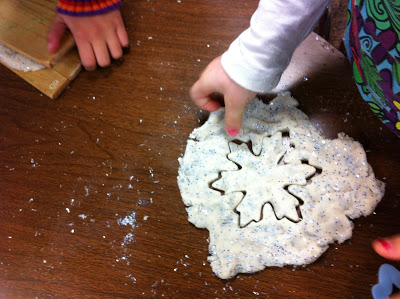Playdough is an important facet of the early childhood environment. Playdough exploration provides important opportunities for the development of fine motor skills (such as pushing, squishing, squeezing, and pinching). And, as many early childhood teachers know, it provides an excellent outlet for releasing tension and stress. It is calming to children!
The Discovery Stage: Ages 3-4
- “piled” and stacked shapes and clumps
- very little detail
- squishing, pinching and poking
- pounding and hitting of playdough pieces with hands and tools
This stage is characterized by the pure sensory experience of the playdough. Attention is on the manipulation and exploration of the playdough for the sheer pleasure of it.
The language of this play at this stage is push, poke, squish, pinch, pound, and so forth. “Watch this!”
The Shape and Form Stage: Ages 4-5
- simple, recognizable forms
- more detail such as mouth and eyes
- beginning of “rolling” coiled, snake-like forms
- begins to make balls
- rolling out and cutting out of forms from cookie cutters and “pretending”
This stage is characterized by having a purpose in using the playdough. Children are engaged in how they can create something out of the playdough. “Things” are made and destroyed.
The language of this play is the narrative of the imagination.
Schematic: Ages 6-7-years-old
- Standing forms and objects
- attention to the details
- making balls and three dimensional shapes
- designs that have patterns and repetitions
- Using basic forms to create people and things in vertical position
This stage is characterized by the child's impulse to create. The playdough becomes more clay-like as children build and create people, dogs, and other things from not only their imagination but their daily lives.
The language of this stage is creativity.
Inspired by the work of Elesse Brown and Stokrocki.








What a lovely and comprehensive overview of development. Thanks for posting!
thank you! since this starts at age 3/4, do you not recommend playdough for any younger?
I was wondering why younger children weren’t included. Younger children can use play dough!
Of course they can! Some children of a younger age are still mouthing materials, so consideration must be taken when offering playdough to young children. This is pointing out the developmental stages of engagement and when children typically engage in these milestones.
Honey – good question! Let me ponder on that!
Playdough is also fantastic for first cutting experiences with sissors – the child can “feel” the cutting. Love reading your blog 🙂
You are so right! I am going to add that to my article! It is such a good activity to prepare those hands for cutting with scissors. Thank you for sharing!
Thank you for your post! I love play-doh…thank goodness I get to “play” with my fair share of it in my line of work (consulting to ECE programs and in play therapy). The mere smell of it transports me back to childhood!
Wendy @Kidlutions
For some reason it has really bugged me that my 3yo takes this awesome three dimensional art material and will *only* use it by squashing it flat and (recently) shaping or cutting out “cookies”. I’ve been able to swallow it and let her be, but it’s nice to see it spelled out that this is normal.
Thanks for sharing this information. I’ve never thought of playing with play-dough having stages. When looking back on the kids that I’ve worked with using play-dough, it makes sense. I’ve included your post on my weekly favorites here: http://play2grow.blogspot.com/2011/04/weekly-favorites-for-april-3-2011.html
hi there just a quick question when providing play dough what developmental considerations need to be made
Great question! I think that the main considerations are for very young children who might explore the playdough by gumming and tasting it. It is a question of engagement at the level of using the playdough with the hands to squeeze, form, and manipulate. If a child is unable to do this – then there are things to look at concerning the scaffolding of use.
This article was so interesting to me because an early childhood educator and caregiver right now, I have never thought of the developmental levels my children are using the play dough. I currently am working with the 3-4 age range, and are spot on to the stage suggested! They enjoy making food, such as pizzas or hotdogs, but also just rip it up into smaller pieces. Play dough is so important for fine motor skills and also building children’s creativity!
Adding natural materials too, we used scented oils and fresh herbs, they cut the herbs or take lavender out of the stems. Used to join rocks to build towers or pretend is cement between bricks. Also, adding markers or paint
Love these ideas!
I feel like the ages of these stages could be tweaked a bit. I have 2 year olds in my class that already are experimenting in the 2nd stage! They are rolling, coiling, making balls, stacking balls to make a “snowman” and naming the shapes they’ve manipulated with the dough.
Sally, You published your play dough recipe somewhere, and I can’t find it now that I am searching for it. Can you post it again? Its an awesome recipe.